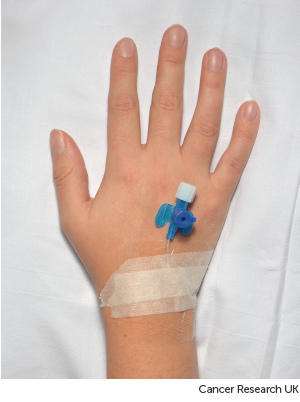Chemotherapy through a small tube (cannula)
Your nurse puts a small tube (called a cannula) into a vein in your hand or arm. This can stay in for a few days if needed.
You might need a cannula after surgery for breast cancer to remove lymph nodes from under your arm. Your doctor or nurse will try not to put the cannula in your arm on the side you had surgery. They should also not put a cannula in a vein in your arm if you have  in it.
in it.

Chemotherapy through a drip
Sometimes your chemotherapy will be added to a drip bag to dilute them, so that they can go into a vein in your arm. This is known as an intravenous infusion.
Your nurse connects a set of plastic tubing to your cannula. The plastic bag containing your treatment attaches to the top of this plastic tubing. The drug solution drips into your vein slowly over a set period of time.
These days, chemotherapy through a drip is almost always run through a pump. The pump gently pushes the chemotherapy into your vein at a carefully controlled rate. Your chemotherapy nurse can set it for the right number of hours. This means you get your chemotherapy at exactly the rate needed.
You can have chemotherapy without a pump. But your nurse will have to keep a much closer eye on the drip rate to make sure it’s going in at the right speed. Even moving your arm can affect the rate of a drip. So using pumps is really a safety precaution.
Possible problems with drips
Doctors often use central lines for chemotherapy because:
- drips into your arm can be temperamental – they can stop and start when you move your arm
- the speed of drips is not as easy to control as it is with a central line connected to a pump
- some people have very fragile veins in their arms – this can make it difficult for the doctors or nurses to get a cannula in
- there is a potential, serious problem with cannulas where fluid can leak out into the surrounding tissues instead of going into the vein. This is called extravasation.
Fluid leaking into surrounding tissue
Any leaking fluid might make the area around the cannula become hard, slightly swollen and sometimes red. Sometimes it’s possible for the doctor or nurse to take the cannula out and put a new one in. And after a day or so the swollen area is usually completely recovered.
But some chemotherapy drugs can cause damage to the tissues if they leak. These drugs are called vesicants. A vesicant drug that leaks can cause pain and ulceration to the body tissues. This doesn't necessarily happen straight away. But the area can become more swollen and painful over the next few days.
Ulcers (sore and broken areas of skin) may develop within 2 weeks. This type of damage can take quite a long time to heal and rarely requires treatment by a plastic surgeon.
Your doctor and nurse know if the drug you’re having is a vesicant. They’ll keep a close eye on the chemotherapy drug to make sure it doesn’t accidentally go into your tissues instead of your vein.
Let them know as soon as possible if you notice that the drip stops going or if the area around the cannula is getting sore.
You need to tell your nurses straight away if you think something may be wrong. Immediate treatment can really help to stop the tissue damage happening in the first place.
This page is due for review. We will update this as soon as possible.



